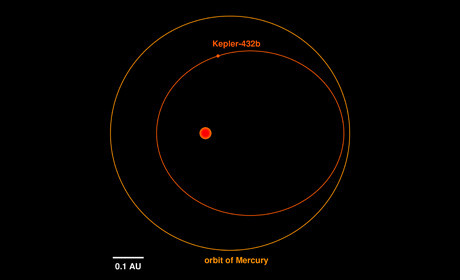Rare exoplanet discovered: Kepler-432b is most dense and biggest detected so far

Astronomers have discovered a rare planet, which is the most dense and the biggest known so far, around 2,850 light years away.
Kepler-432b was detected independently by two groups. It is as big as Jupiter but has six times more mass and orbits its parent red giant star in 52 Earth days.
In an orbit small and highly elongated, the planet has extreme seasons and has been termed a maverick among planets of its type.
Only five such exoplanets have been found so far in such proximity to the parent star, of which only two have been studied in detail, including this one.
"The days of Kepler-432b are numbered, though," adds Mauricio Ortiz, a PhD student at Heidelberg University who led one of the two studies of the planet.
The star around which Kepler-432b is orbiting has already exhausted the nuclear fuel in its core and is gradually expanding. Its radius is already four times that of our Sun and it will get even larger in the future.
As the star is reddish in colour, astronomers call it a "red giant".
In less than 200 million years, the star will most likely swallow up the planet. This short life is believed to be the reason why such planets are rarely observed.
The results of this research were published in "Astronomy & Astrophysics".
The orbit brings the planet incredibly close to its star at times and pushes it much farther away as well, creating enormous temperature differences of ranging between 500 to 1000C across a planet year.
Two research groups of Heidelberg astronomers, one led by Mauricio Ortiz of the Centre for Astronomy of Heidelberg University (ZAH) and the other by Simona Ciceri of the Max Planck Institute for Astronomy (MPIA) in Heidelberg, sighted the rare planet.
"The majority of known planets moving around giant stars have large and circular orbits. With its small and highly elongated orbit, Kepler-432b is a real 'maverick' among planets of this type," said Dr Davide Gandolfi from the state observatory Königstuhl, which is part of the Centre for Astronomy.
Kepler-432b was previously identified as a transiting planet candidate by the Nasa Kepler satellite mission.
Both groups of researchers used the 2.2-metre telescope at Calar Alto Observatory in Andalucía, Spain to collect data. The group from the state observatory also observed Kepler-432b with the Nordic Optical Telescope on La Palma (Canary Islands).
© Copyright IBTimes 2025. All rights reserved.





















